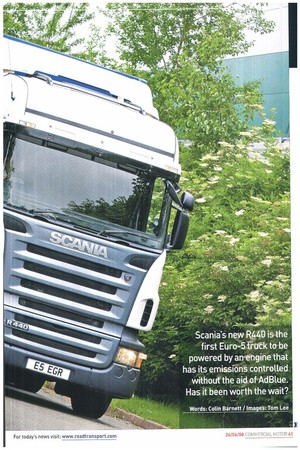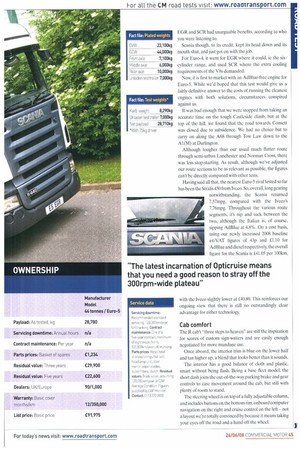Stani
Page 40

Page 41

Page 42

Page 44

Page 45

Page 46

If you've noticed an error in this article please click here to report it so we can fix it.
R4407.,..Hig.hl rt.
Scania's new R440 is the first Euro-5 truck to be powered by an engine that has its emissions controlled without the aiclofAdBlue. Has it been worth the wait?
Words: Colin Barnett / Images: Tom Lee Although we encountered more than the usual number of truck spotters around the CM Scottish route, we couldn't help but wonder if they realised the actual significance of the white Scania passing beneath their feet.
There were few enough clues, just an unfamiliar number on the grille, and while certain rivals may have been tempted to cover the cab in graphics depicting sheep gambolling in green pastures, or dolphins frolicking in the surf, those modest Swedes limited their flamboyance to a personalised number plate — ESEGR. For this was the R440, the first model to be powered by Scania's new family of Euro-5 engines, with emissions controlled without the aid of AdBlue. The headline features of the new engine are XPI common-rail fuel injection, developed in conjunction with Cummins, a variable geometry turbocharger and exhaust gas recirculation, combined with a one-litre increase in cylinder capacity XPI indicates extremely high pressure injection, around 2,400bar compared with the more normal 1,800bar. You can read a full description of the new engine's inner secrets at www. roadtransport.com/ScairdaXPI.
The new engine range, differentiated as 13 litres rather than 12, comes in nominal 40hp increments from 360 to 480hp, in all bar the top rating, a 20hp increase on the previous equivalent. In the 440 tested, torque is also increased by 200Nm to 2.300Nm, developed as a flat line from 1,000 to 1.300rpm before falling off quite sharply.
Apart from the new engine, the plain vanilla exterior masked an almost completely standard fleet-spec Highline 6x2 tractor, the only significant extra being extended side collars behind the cab.
On the road
We mentioned above that the 440's torque delivery tails off at 1,300rpm. Fortunately, this hardly matters since the latest incarnation of Opticruise means you need a good reason to stray off the 300rpm-wide plateau. With our selfimposed 85kph motorway cruising speed, the engine on this 3.08:1 axled example is turning over at just 1,080rpm, so an early override shift down one or two of the twelveplus-two-crawler ratios at the first approach of a significant hill pays dividends as you move up the power curve.
At least 97% of peak power is on tap between 1.300 and 1,900rpm. It must be said, however, that this axle ratio is a bit optimistic for the hills, being better suited to trundling around the M25. Hill mode, not "performancemode, oh no, also extends the shift parameters up the power curve.
The current version of Opticruise is now far more responsive than the original. Asking for speedy progress to nip through a traffic gap could be an attention-grabbing experience while the old microchips woke up, but there are no such issues now —just press and go.
Every so often, the driver might look out and decide the electronics should be doing something, and lo, Opticruise will likely beat you to it.
The right-hand column-stalk controls are all gearbox related. Twist away from you for reverse, and towards you once for normal auto and again for H (hill) mode. Press in the end button to cycle between auto and manual, and push the lever up or down to make manual shifts.
Scania would probably be disquieted if we didn't mention the clutch, so here goes. In a nutshell, we don't understand why it's still there. Six of the seven principal marques have overcome any issues of low-speed control, customer acceptance and all the other excuses, but its retention by Scania is now just an illogical distraction. It's like having a 42-inch plasma HD TV with a monochrome display. End of grumble.
A wet test track discouraged us from full brake testing, but around the near 800km of the test route, nothing in the braking set-up gave any indication of being less than you'd expect. The standard exhaust brake is surprisingly effective, especially when operated by the floor button, which down shifts to give optimum revs.
It also works on the first bit of brake pedal travel, but without the gear changes. The button position gets a hit uncomfortable after extended use though.
The ride was firm enough to be a positive benefit to the handling, but in the acid test, sitting on the unsprung twoway folding passenger seat was not an uncomfortable experience, apart from the non-height-adjustable seat-belt mounted to the cab wall.
Productivity Amid the initial, and sometimes acrimonious, war of words that heralded the arrival of the Euro-4 and Euro-.5 emission standards, the received wisdom was that both EGR and SCR had unarguable benefits, according to who you were listening to.
Scania though, to its credit, kept its head down and its mouth shut, and just got on with the job.
For Euro-4, it went for EGR where it could, ie the sixcylinder range, and used SCR where the extra cooling requirements of the V8s demanded.
Now, it is first to market with an AdBlue-free engine for Euro-5. While we'd hoped that this test would give us a fairly definitive answer to the costs of running the cleanest engines with both solutions, circumstances conspired against us.
It was bad enough that we were stopped from taking an accurate time on the tough Castleside climb, but at the top of the hill, we found that the road towards Consett was closed due to subsidence. We had no choice but to carry on along the A68 through Tow Law down to the Al (M) at Darlington.
Although tougher than our usual much flatter route through semi-urban Lanchester and Norman Cross, there was less stop-starting. As result, although we've adjusted our route sections to be as relevant as possible, the figures can't be directly compared with other tests.
Having said all that. the nearest Euro-5 rival tested so far has been the Stralis 450 from iveco. So, overall, long gearing notwithstanding, the Scania returned 7.57mpg, compared with the Iveco's 7.76mpg. Throughout the various route segments, it's nip and tuck between the two, although the Italian is, of course, sipping AdBlue at 4.8%. On a cost basis, using our newly increased 2008 baseline ex-VAT figures of 43p and £1.10 for AdBlue and diesel respectively, the overall figure for the Scania is £41.05 per 100km, with the Iveco slightly lower at £40.80. This reinforces our ongoing view that there is still no outstandingly clear advantage for either technology.
Cab comfort
The R cab's "three steps to heaven" are still the inspiration for scores of custom sign-writers and are easily enough negotiated for more mundane use.
Once aboard, the interior trim is blue on the lower half and tan higher up, a blend that looks better than it sounds.
The interior has a good balance of cloth and plastic. smart without being flash. Being a base fleet model, the short dash joins the out-of-the-way parking brake and gear controls to ease movement around the cab, but still with plenty of room to stand.
The steering wheel is on top of a fully adjustable column, and includes buttons on the bottom rim. onboard computer navigation on the right and cruise control on the left — not a layout we're totally convinced by because it means taking your eyes off the road and a hand off the wheel. Well-proportioned mirrors include a main lens and a smaller wide angle on each side, with kerb and front-view mirrors on the nearside. The four main lenses are heated, but only the nearside main one is electrically adjustable. Good visibility is guaranteed due to Scania's dropaway dash and side windows.
Standard spec means none of the usual press fleet adornments, but everything that is there is superbly engineered. The instrument panel is a model of understated clarity and every switch has a quality feel.
The quality feel is confirmed by the noise meter readings, the R440 joining a short, and almost exclusively Scania, list of trucks recorded at less than 50dB(A) at tickover. The external sun visor does marr the effect at higher speeds.
Storage is generous enough for double manning if required. Under-bunk lockers have internal and external access on the right, but internal only on the left.
Between these is a large storage drawer under the centre bunk. There's also a smaller drawer under a lower dash centre table, moderately sized door pockets, and a twolitre bottle holder and ashtray by the driver's left knee, although, apparently, if you delete the ashtray, you get a much better beverage holder.
The lid of the shallow tray in front of the passenger has a handy recess, which appears to be just the right size for a British Standard bar towel.
Above the windscreen, there's a lockable tray, along with a cleverly fitted briefcase-cum-clipboard and a slightly unfamiliar Stoneridge tacho.
There is a three-section storage area above this, which is currently open-fronted apart from a clever net in the largest central section. This is due to be changed to a lidded arrangement as standard. Auxiliary power requirements feature a cigar lighter in the ashtray, with a 12V two 24V power outlets further left.
The bunk area features reading lamps, one up and two down, a smoke alarm, oddment net and a wanderlead remote for radio, alarm clock and heating functions. The lower bunk does feature a bit of a jigsaw element to maximise the utilisation of space, but it's no big deal. •








































































































































































